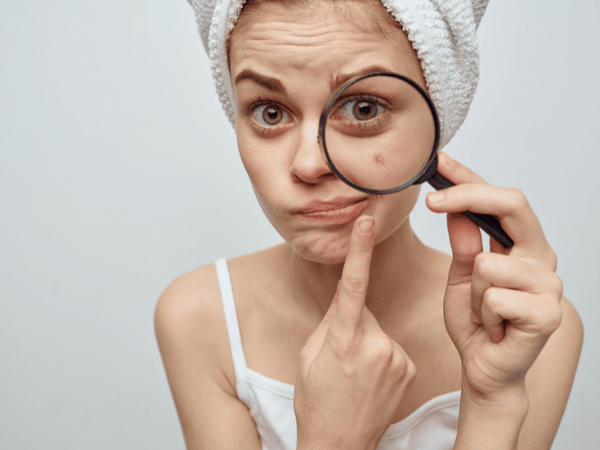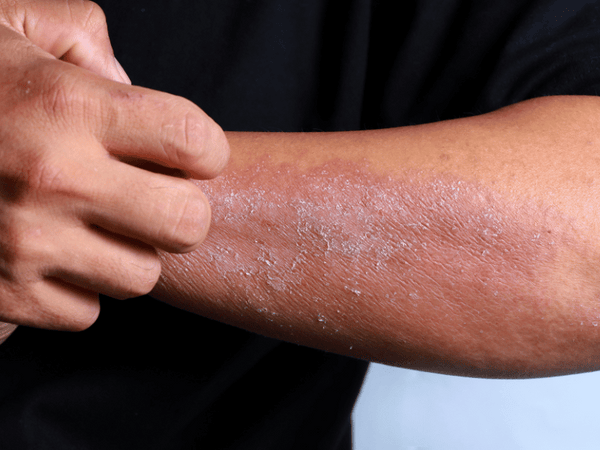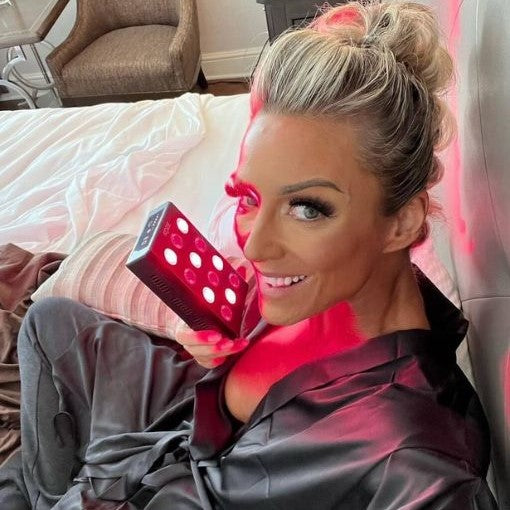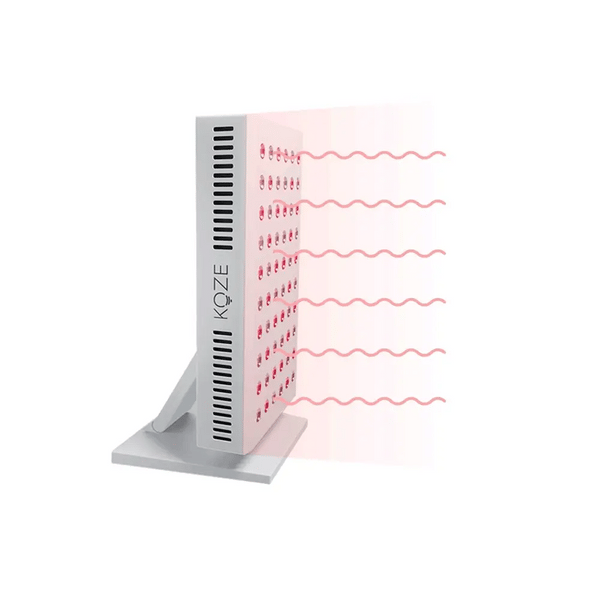
Red Light Therapy for Skin Conditions: Acne and Eczema
Red Light Therapy for Skin Conditions: Acne and Eczema
Maintaining healthy skin is crucial not only for aesthetic reasons but also for overall well-being. Skin conditions such as acne and eczema can significantly impact one's confidence and quality of life. Red light therapy has emerged as a promising treatment option for these common skin issues. This blog post will delve into how red light therapy works, its benefits, and how it can be effectively used to treat acne and eczema.
Red Light Therapy for Acne

Acne is a common skin condition that affects millions of people worldwide. It occurs when hair follicles become clogged with oil and dead skin cells, leading to inflammation, redness, and sometimes infection. Red light therapy for acne has gained popularity due to its non-invasive nature and effectiveness in reducing acne symptoms.
Understanding Acne: Causes and Symptoms
Acne can be triggered by various factors, including:
- Hormonal Changes: are often seen during puberty, pregnancy, and menstruation.
- Excess Oil Production: Overactive sebaceous glands can lead to clogged pores.
- Bacteria: The bacterium Propionibacterium acnes can proliferate in clogged pores, causing inflammation.
- Diet: Certain foods, particularly those high in sugar and dairy, can exacerbate acne.
- Stress: Can increase oil production and exacerbate acne symptoms.
Common symptoms of acne include:
- Pimples: Small, red, tender bumps.
- Blackheads and Whiteheads: Clogged pores that appear black or white.
- Cysts: are large, painful lumps beneath the surface of the skin.
How Red Light Therapy Helps with Acne
Red light therapy targets the root causes of acne in several ways:
-
Reducing Inflammation: The anti-inflammatory properties of red light help to calm irritated skin and reduce redness.
2. Killing Acne-Causing Bacteria: Red light can penetrate the skin and kill the bacteria responsible for acne, reducing the number of active breakouts.
3. Promoting Skin Healing: By stimulating cellular repair and regeneration, red light therapy helps to heal existing acne lesions and prevent future scarring.
Benefits of Light Therapy for Acne
Using red light therapy for acne offers several advantages:
- Non-Invasive: Unlike some acne treatments, red light therapy does not involve harsh chemicals or invasive procedures
- No Downtime: Treatments are quick and do not require recovery time, allowing users to continue with their daily activities.
- Suitable for All Skin Types: Red light therapy can be used on all skin types without causing irritation.
- Long-Term Benefits: Regular use can lead to sustained improvements in skin health and acne reduction.
How to Use Red Light Therapy for Acne Treatment
To achieve the best results with led light therapy for acne, follow these guidelines:
- Recommended Devices: Look for FDA-approved red light therapy devices specifically designed for acne treatment.
- Treatment Frequency and Duration: Most experts recommend using red light therapy for 10–20 minutes per session, 3-5 times per week. Consistency is key to seeing results.
- Application Tips: Cleanse your face before treatment, and use the device according to the manufacturer's instructions. Ensure the light is evenly distributed across the affected areas.
Potential Side Effects and Precautions
While red light therapy is generally safe, it's important to be aware of potential side effects and take precautions:
- Temporary Redness: Some users may experience mild redness after treatment, which usually subsides within a few hours.
- Dryness: If you notice dry skin, incorporate a hydrating moisturizer into your skincare routine.
- Eye Protection: Always use protective goggles to prevent potential eye damage during treatment.
Red Light Therapy for Eczema

Eczema, also known as atopic dermatitis, is a chronic skin condition characterized by inflamed, itchy, and often painful patches of skin. It can significantly impact the quality of life, causing discomfort and emotional distress. Red light therapy to treat eczema has emerged as a promising treatment option, offering relief and promoting healthier skin.
Understanding Eczema: Causes and Symptoms
Eczema can be triggered by a combination of genetic and environmental factors. Common causes and triggers include:
- Genetics: A family history of eczema or other allergic conditions.
- Immune System Dysfunction: An overactive immune response can lead to skin inflammation.
- Environmental Factors: Exposure to allergens, irritants, and changes in weather can exacerbate symptoms.
- Stress: Can trigger or worsen eczema flare-ups.
- Skin Barrier Defects: A weakened skin barrier can make skin more susceptible to irritants and allergens.
Symptoms of eczema vary but often include:
- Dry, Itchy Skin: Persistent itching that can lead to scratching and further irritation.
- Red, Inflamed Patches: Areas of skin that are red, swollen, and sometimes painful.
- Blisters and Oozing: In severe cases, eczema can cause blisters that may ooze and crust over.
- Thickened Skin: Chronic scratching can lead to thickened, leathery patches of skin.
How Red Light Therapy Helps with Eczema
Red light therapy may help manage eczema symptoms by addressing the underlying causes of the condition:
-
Reducing Inflammation: The anti-inflammatory properties of red light help to calm the skin and reduce redness and swelling.
2. Soothing Itching and Irritation: Red light therapy can alleviate the persistent itching associated with eczema, providing relief.
3. Enhancing Skin Barrier Function: By promoting cell regeneration and repair, red light therapy helps to strengthen the skin barrier, making it more resilient to irritants and allergens.
Benefits of Using Red Light Therapy for Eczema
Using red light therapy for eczema offers several significant benefits:
- Non-Invasive Treatment: Provides relief without the need for topical steroids or other potentially harmful medications.
- Quick and Painless: Treatments are painless and can be completed in a short amount of time.
- Suitable for All Ages: It is safe for use on both adults and children, making it a versatile treatment option.
- Long-Term Relief: Regular use can lead to sustained improvements in skin health and a reduction in eczema flare-ups.
How to Use Red Light Therapy for Eczema Treatment
To achieve the best results with red light therapy for eczema, follow these guidelines:
- Recommended Devices: Choose a high-quality, FDA-approved red light therapy device designed for skin treatment.
- Treatment Frequency and Duration: Experts recommend using red light therapy for 10-20 minutes per session, 3-5 times per week. Consistent use is crucial for effective results.
- Application Tips: Cleanse the affected areas before treatment. Hold the device at the recommended distance and ensure even coverage of the red light across the skin.
Potential Side Effects and Precautions
While red light therapy is generally safe, it is important to be aware of potential side effects and take necessary precautions:
- Temporary Redness: Some users may experience mild redness post-treatment, which typically resolves within a few hours.
- Dryness: If dryness occurs, use a gentle, hydrating moisturizer to keep the skin moisturized.
- Eye Safety: Always wear protective goggles to prevent potential eye damage during treatment sessions.
What is Red Light Therapy?
Red light therapy (RLT) is a non-invasive treatment that uses low-level wavelengths of light to penetrate the skin. This therapy is known for its ability to rejuvenate the skin, reduce inflammation, and promote healing. Originally developed by NASA to help plants grow in space, red light therapy has since found applications in various medical and cosmetic fields.
How Red Light Therapy Works
Red light therapy works by emitting red light at specific wavelengths (typically between 630 and 660 nanometers) and near-infrared light (810 and 850 nanometers). These wavelengths penetrate the skin and are absorbed by the mitochondria, the powerhouses of cells. This absorption boosts cellular energy production, leading to increased cell proliferation and repair.
Types of Light Therapy Devices
There are various types of red light therapy devices available, ranging from handheld devices to full-body panels. Here are a few common types:
- Handheld Devices: portable and easy to use for targeted treatment.
- Face Masks: are designed to treat facial skin issues.
- Panels: Larger devices that can treat broader areas of the body.
- Beds: Full-body devices often used in professional settings.
Benefits of Red Light Therapy
Red light therapy offers numerous benefits, including:
- Reduction of Inflammation: Helps to calm irritated skin.
- Improved Skin Tone and Texture: Promotes a more even skin tone and smoother texture.
- Enhanced Healing: Accelerates the healing process of wounds and scars.
- Anti-Aging Effects: Stimulates collagen production, reducing the appearance of fine lines and wrinkles.
FAQs About Red Light Therapy for Skin Conditions
Red light therapy has gained significant attention for its potential benefits in treating skin conditions like acne and eczema. Here are some frequently asked questions (FAQs) to help you understand this therapy better.
Is Red Light Therapy Safe for All Skin Types?
Yes, red light therapy is generally safe for all skin types. Unlike some treatments that may cause irritation or adverse reactions on sensitive skin, red light therapy is non-invasive and gentle. However, it’s always recommended to perform a patch test and consult with a healthcare professional before starting any new treatment.
How Long Does It Take to See Results?
The time it takes to see results from red light therapy can vary depending on the individual and the severity of the skin condition. Most people start to notice improvements after 4-6 weeks of consistent use. For optimal results, it’s important to follow the recommended treatment schedule and be patient, as skin healing and regeneration take time.
Can Red Light Therapy Be Used on Sensitive Skin?
Yes, red light therapy can be used on sensitive skin. Its gentle, non-invasive nature makes it suitable for individuals with sensitive skin types. However, it’s essential to start with shorter sessions and gradually increase the duration as your skin adjusts to the treatment.
Are There Any Contraindications?
While red light therapy is safe for most people, there are some contraindications to consider like anyone with a history of certain conditions, including skin cancer and inherited eye diseases.
- Photosensitivity: Individuals with conditions that cause photosensitivity or those taking medications that increase sensitivity to light should consult a healthcare professional before starting red light therapy.
- Pregnancy: Pregnant women should seek medical advice before using red light therapy.
- Eye Protection: Always use protective goggles during treatment to prevent potential eye damage.
How Do You Maintain Results After Treatment?
To maintain the benefits of laser therapy, consider incorporating the following practices into your routine:
- Consistent Use: Continue using red light therapy regularly, even after seeing improvements, to sustain results.
- Skincare Routine: Follow a gentle skincare routine that includes moisturizing and sun protection.
- Healthy Lifestyle: Maintain a healthy diet, stay hydrated, and manage stress levels to support overall skin health.
Is red light therapy a standalone treatment?
Red light therapy can be used as a standalone treatment or in conjunction with other therapies. Many people find it beneficial to combine red light therapy with other skincare treatments, such as topical creams or medications, for enhanced results. Always consult with a healthcare provider to create a comprehensive treatment plan tailored to your needs.
How does red light therapy compare to other light therapies?
Red led light therapy differs from other light treatment in several ways:
- Red Light Therapy: Uses light wavelengths between 630-660 nm and near-infrared light (810-850 nm) to penetrate the skin, reduce inflammation, and promote healing.
- Blue Light Therapy: Primarily used for acne treatment, blue light therapy targets acne-causing bacteria on the skin's surface.
- UV Light Therapy: Often used for conditions like psoriasis, UV light therapy can be more aggressive and carry risks of skin damage with prolonged use.
What Should I Look for in a Red Light Therapy Device?
When choosing a red light therapy device, consider the following features:
- Wavelength: Ensure the device emits light in the therapeutic range (630–660 nm and 810–850 nm).
- FDA Approval: Look for devices that are FDA-approved for safety and effectiveness.
- Coverage Area: Choose a device that suits your needs, whether it’s a handheld device for targeted treatment or a larger panel for broader coverage.
- User Reviews: Check user reviews and testimonials to gauge the device’s effectiveness and reliability.
Can red light therapy be overused?
Yes, overuse of red light therapy can lead to diminishing returns and potential skin irritation. It’s important to follow the recommended guidelines for treatment duration and frequency. Typically, sessions should last between 10-20 minutes, 3-5 times per week. Consistency, rather than intensity, is key to achieving the best results.
Conclusion
Red light therapy is a powerful and effective treatment for skin conditions like acne and eczema. This non-invasive therapy reduces inflammation, soothes irritation, and promotes skin healing by using specific wavelengths of light.
For acne sufferers, red light therapy targets bacteria and helps prevent scarring, leading to a clearer complexion. Those with eczema can benefit from its anti-inflammatory properties, reducing redness and improving skin barrier function.
Safe for all skin types and ages, red light therapy offers minimal side effects and can be used alone or alongside other treatments. Consistent use is key to achieving the best results, making it a valuable addition to any skincare routine.
Consult with a healthcare professional before starting red light therapy to ensure it's right for you and to develop an effective treatment plan. Regular use can lead to significant improvements in skin health and overall well-being.
In summary, red light therapy provides a safe, effective, and non-invasive option for managing acne and eczema, helping you achieve healthier, clearer skin.




